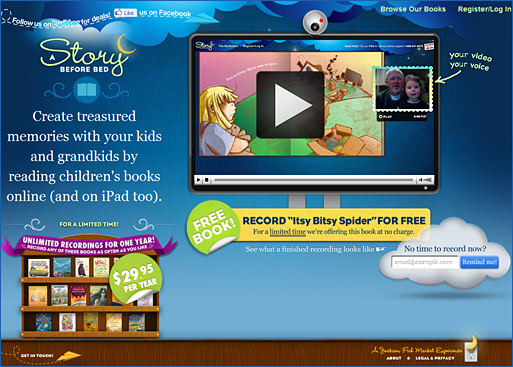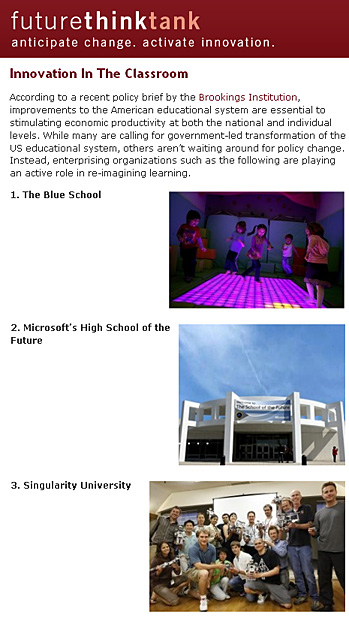How to get started with open source in K-12 — from The Journal by Natasha Wanchek
Open source has proved attractive for K-12 school districts for any number of reasons, from upfront cost savings to freedom from cumbersome restrictions to the quality of the software itself. But how does a school or district get started with it? Three K-12 IT directors shared their experiences with THE Journal–the good and the bad, as well as the lessons they’ve learned in the process.
What teachers want in digital tech: The video — by Frank Catalano, Principal, Intrinsic Strategy — via EdNetNews.com
As the session moderator and organizer, I saw every video several times. I also saw a number of themes that kept recurring whether the submission was from California or Georgia, Saskatchewan or Alberta (we received videos from 14 states and two provinces). Even though this was a tech-savvy, self-selecting group of teachers and not anything vaguely resembling a scientific sample, the common themes may be important to all providers of educational materials—because teachers who are willing to speak out, on video, in front of 300 educational publishing execs are also likely to be the greatest promoters, or detractors, of whatever the same companies have to offer their schools.
The top five themes, in no particular order:
1) All digital content should work with all classroom technology devices.
2) Provide collaboration and content creation tools for students to use.
3) Provide teacher training both for using and integrating technology tools and resources.
4) Make digital materials editable and searchable.
5) Include more video and music in digital resources.
——-
Videos from the Content in Context session are viewable on YouTube at http://www.youtube.com/user/edpublishing in the Teacher Video Challenge playlist, and comments about the videos are online in the Classrooms in the Digital Age community on edWeb.net.
Online learning continues to expand — by M. Horn
For those naysayers who have been suspect of whether online learning would continue to grow in the highly regulated K-12 sector as disruptive innovations do, more evidence emerged recently to suggest that it’s not just us and the theory saying that it will do that, but it is in fact doing just that.
According to a report titled Speak Up 2009 released by Blackboard and Project Tomorrow, a whopping 27 percent of high school students took at least one online course in 2009—nearly double the 14 percent who took at least one online course in 2008.
Kids Innovation Study Results, Part 2: Creation, Design & Digital Optimism — from life-connected.com by Kim Gaskins
This is part 2 of the study results discussion. Part 1: “Kids Innovation Study Results, Part 1: Web in the Physical World.” Download a 3-page PDF summary of study results.
Children’s “Future Requests” for Computers and the Internet
Study Lead: Jessica Reinis
What do children think computers should be doing? Children’s “Future Requests” for Computers and the Internet is the second installment of Latitude 42s: an Open Innovation Series, user- powered research studies which unite collective creativity and sophisticated quantitative analysis to generate Web-based solutions for the future.
How to teach with technology: Science and math — Edutopia.org
Also see:
Big Thinkers: Katie Salen on Learning with Games — Edutopia.org
A professor of design and technology at Parsons The New School for Design talks about the value of games and the empowerment of play.
How to Build a Technology-Based Curriculum — Edutopia.org
Educators emphasize that infrastructure must precede innovation.
Study shows which technology factors improve learning — EdNetNews.com
Technology-assisted classes help students stay in school – reducing drop-out rates
- The most important factor that Project RED found in reducing drop-out rates is using technology frequently in intervention classes. Students in reading intervention, special education, Title I (poverty program) and English Language Learners benefit from the individualized instruction that technology can provide best.
- Principal leadership is the second most important factor in reducing dropout rates. Change management requires trained and committed leaders who are able to drive the school culture in new directions. Principals who model and lead technology usage are associated with schools with reduced dropout rates.
- Daily use of technology in core classes is the third most important factor. Just as students can take control of their iPod, they also want to take control of their learning. Student engagement is one of the serious issues facing schools with high-entertainment-value options available elsewhere,
“We found that technology-infused classes in core subject areas, such as science and math, and in intervention classes such as Reading, Title I, English Language Learners and special education, were a significant factor in improvement. They were Key Implementation Factors in higher high stakes test score improvements, dropout rate reduction,, and improved discipline, tied with low students per computer ratios, “ said Jeanne Hayes, President of the Hayes Connection and co-author of the study.
- Schools with 1:1 learning programs have better education success than do schools with fewer computing devices. Schools with one computing device per student also performed significantly better than schools with higher ratios, such as 3 students per computer.
- Schools with 1:1 programs reported a 15 point reduction in disciplinary actions and a 13 point decrease in dropout rates as compared to all other schools.
- Schools with properly implemented programs – those with frequent use of collaboration and online testing for improvement – found even greater gains. Compared to all 1:1 schools, properly implemented programs report a 15 point gain in high stakes test score improvement and even larger improvements in graduation rates and college attendance plans.
Here are some excellent resources re: eBooks and the iPad — from Johnny Ansari, Calvin College’s Teaching & Learning Digital Studio
…
…
…
The Sound of Music (and Technology) — from Edweek.org by Ian Quillen
While technology and music are usually thought of in a commercial sense, Bauer highlighted [at the ISTE 2010 Conference] resources that can help students compose, perform, and respond to music in academic settings, and even, on occasion, serve as a bridge between music and other areas of study.
Some tools mentioned include:
- Apple’s Garage Band
- Musescore
- Noteflight
- The San Francisco Symphony’s kids website, which offers interactive musical content
- An online tuner or metronome, downloading Audacity to record and self-evaluate performances, or logging onto the Project Gutenberg‘s sheet music database to print out free scores. There are even online video tutorial databases like the Michael Hopkins String Pedagogy Notebook.
Videoconferencing Lesson Study: Learning from the Classroom — by Janine Lim
Poster Session: Amy Colucci, Jefferson County Public School with Jeremy Renner
Just stopped by a poster session on the way that Jefferson County Public Schools uses classroom-based videoconferencing systems to facilitate real-time lesson studies without interrupting the classroom instructional.
I talked to Pam Caudill, who is the videoconferencing contact supporting the project. It’s a really cool professional development model. (In case you’re interested, they are using Tandberg equipment.)
So imagine this:
- The model teacher is in the classroom – and videoconferences back with a group of teachers at another site.
- She explains the idea for the lesson; prep etc.
- She teaches the lesson. The teachers at the other site are watching. A mic is on the teacher, and a room mic is used also. Someone in the room unobtrusively manages the camera so the far site sees everything going on.
- After the lesson, the model teacher debriefs with the teachers at the far site.
- THEN, the teachers at the far site learn how to use the technology tools they just saw used with the students.
Learning in the 21st Century: 2010 Trends Update — from Project Tomorrow
Key trends highlighted in the report include:
- The number of high school students who are taking online classes for school credit has almost doubled since Speak Up 2008.
- While the number of teachers who have taught online classes has tripled since Speak Up 2008, we still have more work to do to help teachers learn how to effectively leverage online learning to drive student achievement and increase their own productivity.
- Even as aspiring teachers are gaining experience with online classes and online professional learning communities as part of their teacher preparation programs, only 4 percent report that they are learning how to teach online classes in their instructional methods courses.
- Administrators are beginning to shift their focus on online learning from professional development for teachers to online classes for students.
- Thirty-three percent of parents report they have taken an online class for their own professional needs or personal interests. Parents’ personal experiences with online learning are affecting how their children view the benefits of online learning as well.
See also:
Report: Online Learning Nearly Doubles Among High School Students — The Journal by David Nagel
See also:
Spurring Innovation Through Education: Four Ideas — from the Brookings Institution
CFTL releases Ready to Succeed in the Classroom and Grappling with the Gaps
The Center for the Future of Teaching and Learning today released two reports: Grappling with the Gaps and Ready to Succeed in the Classroom. The Center’s work in this area is part of the broader Ready to Succeed Initiative funded by the Stuart Foundation, which focuses on improving educational outcomes for children and youth in the foster care system (emphasis DSC).
Grappling with the Gaps identifies current gaps in the research on the education of children and youth in foster care based on interviews with twelve experts in education and child welfare from across the nation.
Ready to Succeed in the Classroom includes a suite of documents that brings forward the voices of classroom teachers. Through a series of discussion groups held by the Center for the Future of Teaching and Learning, experienced teachers shared their ideas, advice, strategies, and recommendations for how to improve the educational outcomes for these students. The publications provide practical advice and ideas for classroom teachers, school and district administrators, and community members.
For example, experienced teachers, who have had children and youth in their classrooms who are in the foster care system, share their beliefs that it is important to keep expectations high and make them absolutely clear and consistent, whether they are about learning, respect, classroom behaviors, effort, or anything else. Although teachers expressed a great deal of compassion and sympathy for their students in the foster care system, they also felt that lowering or altering expectations for these students constituted a profound disservice to them. “I tell them the past doesn’t have to shape the future,” one teacher explained.
Ready to Succeed in the Classroom and Grappling with the Gaps are now available for free download at our Website: http://www.cftl.org/whatsnew.php
















